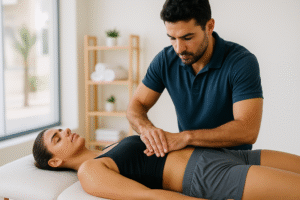
Myofascial Release Guide: Relieve Pain & Restore Mobility
Discover doctor-led myofascial release that targets fascia, eases chronic pain, and boosts flexibility. Personalized manual therapy restores natural movement.
Navigating the world with confidence and stability is a cornerstone of a fulfilling life. For many seniors and individuals facing mobility challenges, this can become a daily concern. The introduction of a mobility aid—be it a cane, walker, or another device—is not a sign of defeat, but a powerful step towards regaining independence, safety, and freedom. Proper mobility aids usage is the key that unlocks this potential, transforming a simple tool into a reliable partner in your journey. At Physio Cure Dubai, we believe that with the right device and expert guidance, you can continue to live an active and engaged life. Our specialized geriatric physiotherapy programs are designed to empower you with the skills and confidence needed to master your mobility.
The journey to enhanced mobility begins with a crucial first step: selecting the right aid. With a wide array of options available, from simple canes to sophisticated rollators, making the correct choice can feel overwhelming. This is where the risk of self-selection becomes apparent. Choosing a device based on a friend's recommendation or a quick online search can lead to using an aid that is ill-suited for your specific needs, potentially increasing your risk of falls, causing postural problems, or even worsening your condition. This decision is not just about picking a product; it's about a clinical assessment of your body's unique requirements.
At Physio Cure Dubai, our "Doctor-Led" philosophy is central to this process. A thorough evaluation by a Doctor of Physical Therapy is essential to perform a "Root-Cause Diagnosis." We don't just see a person who needs a walker; we see an individual with a specific pattern of muscle weakness, a particular balance deficit, or a distinct gait abnormality. This detailed understanding allows us to recommend the most effective mobility aid. A professional assessment ensures the device matches your physical capacity, lifestyle, and goals, laying a safe and effective foundation for your mobility.
Our physiotherapists consider a comprehensive set of factors before making a recommendation. This holistic approach ensures the aid becomes a seamless extension of your body, providing support exactly where and when you need it. We analyze:
The walking cane is one of the most common mobility aids, but its simplicity can be deceptive. Using it correctly is vital for it to provide the intended support and prevent the development of poor postural habits. From sizing to technique, every detail matters.
An improperly sized cane is not only ineffective but can also cause new problems, such as shoulder, neck, or back pain. To find the perfect height, follow this simple procedure:
One of the most frequent mistakes in cane usage is holding it on the same side as the weak or painful leg. The cane should always be held in the hand opposite to the side that needs support. This technique creates a wider base of support and mimics a natural, reciprocal walking pattern. Here’s how to walk correctly:
Safety Tip: The rubber tip (ferrule) on the bottom of your cane is like the tread on a tire. Inspect it regularly for wear and tear. A worn-out, smooth tip can slip easily on wet or smooth surfaces. Replacements are inexpensive and essential for safety.
For those who need more significant support, a walker is an excellent tool for maintaining independence. Whether you're using a standard walker (which you lift) or a rollator (which you push), understanding the core principles of walker safety tips is paramount to preventing falls and moving with confidence.
The single most important rule of walker use is to stay inside the frame. Many users make the mistake of pushing the walker too far ahead and then hunching over to reach it. This compromises your center of gravity and actually increases your risk of falling. Your walker is there to support your body, not to be chased after.
Keep the back legs of the walker even with your mid-foot as you step. This ensures your body remains upright, your posture is protected, and the walker can provide maximum support. A proper fit is also key; like a cane, the walker's handles should be at wrist height, allowing for a slight, comfortable bend in your elbows. This focus on posture is critical, as poor habits can lead to other issues like back pain, a condition we treat comprehensively with advanced modalities, including manual therapy and specialized technologies like spinal decompression for underlying spinal issues.
Crucial Safety Tip: Never, ever pull on your walker to stand up from a seated position. The walker can easily tip over, leading to a serious fall. Always push up from the arms of your chair or your bed, and only hold onto the walker once you are stable and upright.
Everyday movements require a mindful approach when using a walker.
A mobility aid is a powerful tool, but it is only one part of the equation. True, lasting mobility comes from a holistic program that addresses the underlying issues of weakness, pain, and imbalance. This is where expert mobility aid physiotherapy guidance becomes indispensable. Our mission at Physio Cure Dubai is to empower you to live your healthiest life, and that means going beyond simply handing you a device.
Our structured "Patient Journey" ensures that your care is comprehensive. We start with a free initial assessment to understand your unique situation. Then, we move to a root cause diagnosis. From there, we create a "100% Personalized Care" plan that integrates the mobility aid into a broader therapeutic strategy. This plan isn't just about walking; it's about building a stronger, more resilient you. It includes:
Our team of highly qualified physiotherapists, including specialists like Dr. Talaat Abdelhakeem in geriatric and orthopedic rehabilitation, brings a wealth of experience and a compassionate approach to your care. We believe in collaboration, working closely with you to set and achieve your personal goals. You can learn more about the experts dedicated to your recovery on our Our Team page. We don't offer quick fixes; we offer lasting solutions that require your active participation and commitment.
Don't let mobility challenges define your life. Take control of your movement with expert guidance. Contact Physio Cure Dubai today to learn how our specialized physiotherapy programs can help you use mobility aids safely and effectively to reclaim your independence.

Discover doctor-led myofascial release that targets fascia, eases chronic pain, and boosts flexibility. Personalized manual therapy restores natural movement.
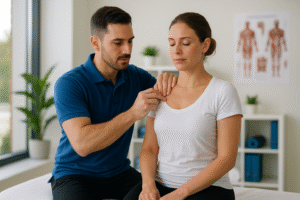
Learn how doctor-led trigger point therapy at Dubai’s leading clinic conquers chronic muscle knots, boosts mobility, and delivers lasting, root-cause pain relief.
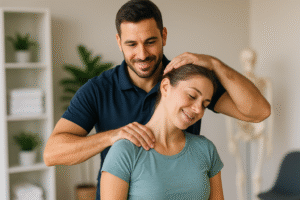
Discover how joint manipulation targets pain at its source, boosts mobility, and speeds recovery. Explore doctor-led physiotherapy for lasting relief.
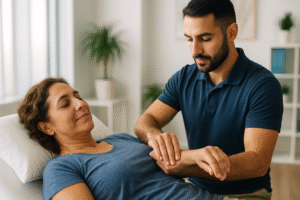
Discover doctor-led soft tissue mobilization that targets pain, breaks scar tissue, and restores full movement. Book evidence-based physiotherapy in Dubai.
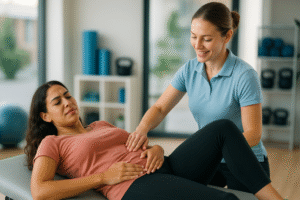
Endometriosis pain doesn’t have to rule your life. Physiotherapy targets root causes, releases pelvic tension, and restores comfort. Book a consult today.
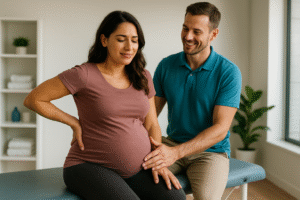
Discover doctor-led physiotherapy for pregnancy lower back pain relief. Gain root diagnosis, customized exercises, and guidance for a pain-free journey.
Physio Cure Dubai, located in Dubai Silicon Oasis, offers a comprehensive range of physical therapy services. Our team of the best physiotherapists in Dubai are all real doctors providing personalized care, using the latest technologies and evidence-based techniques to help you, your child, and your loved ones recover and live a pain-free life.
DHA License No. 5411940
1510, SIT Tower, Dubai Silicon Oasis